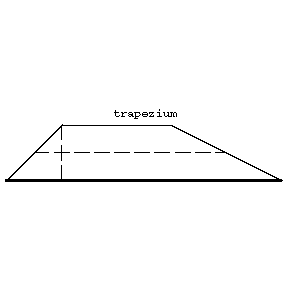Trapezium
A convex quadrilateral (cf. Quadrangle, complete) for which two of the sides are parallel and the other two are non-parallel (see Fig.). The parallel sides are called the bases of the trapezium, while the non-parallel sides are called its lateral sides; the line segment joining the midpoints of the lateral sides of the trapezium is called the median line; the median line is parallel to the bases of the trapezium and is equal to half their sum. The area of a trapezium is equal to the product of the length of the median line by the height of the trapezium, or to half the product of the diagonals by the sine of the angle between them. A trapezium whose lateral sides are equal is called equilateral.

Figure: t094020a
Comments
In the English literature, a trapezium is also called a trapezoid.
Trapezium. BSE-3 (originator), Encyclopedia of Mathematics. URL: http://encyclopediaofmath.org/index.php?title=Trapezium&oldid=18416